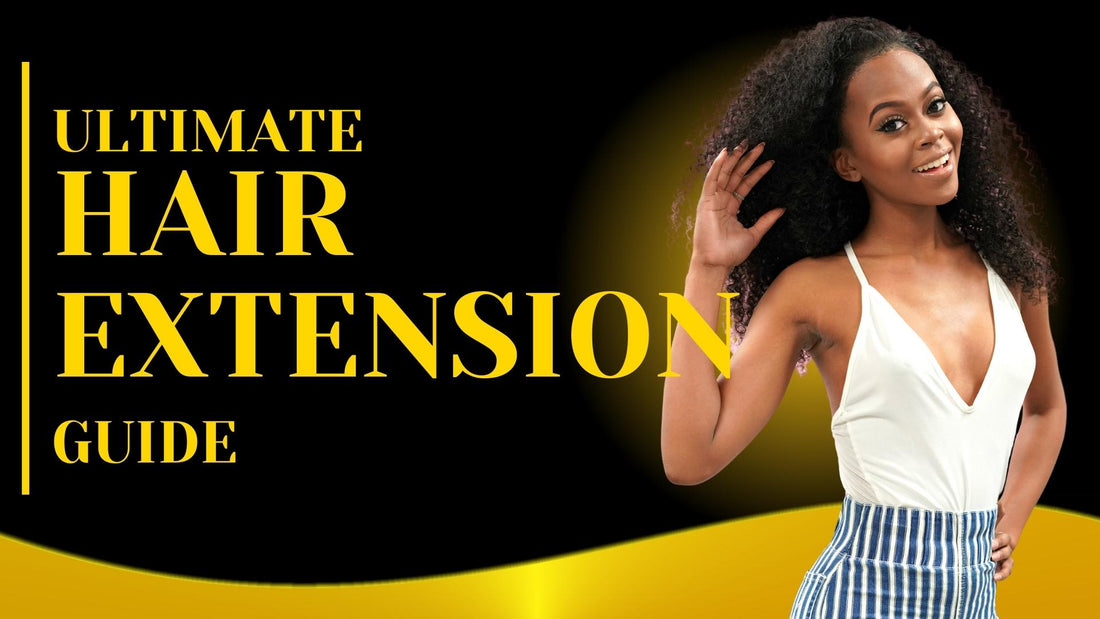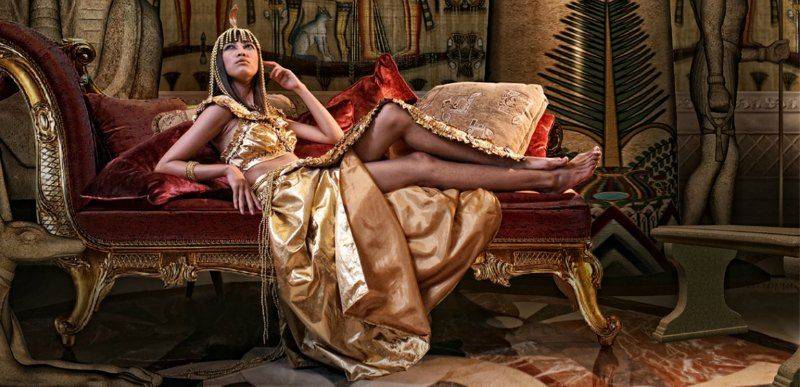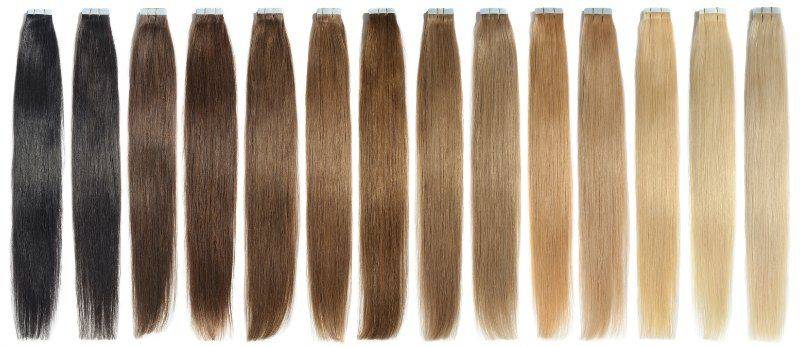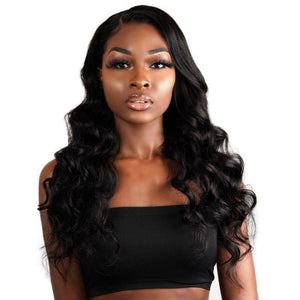The Ultimate Guide to Hair Extensions
With so many types, styles, grades, applications, and textures, you might get lost when thinking about how big the hair extensions industry has become.
Now in our modern-day culture, everyone is wearing weave!
What bride is not wearing clip-in extensions, or teen with the perfect style sew-in extensions for prom. Hair is now bigger than just special events while hair extensions have now become a part of many women's everyday life.
If you want to know everything about hair extensions we should talk about how it all got started.
History of Hair Extensions
You might be wondering, “When did this crazy fad start?”
Let’s go back to the ancient Egyptians; that’s right!
The origin of hair extensions goes back to the Queen of the Nile, Cleopatra. Cleopatra was the most desired and beautiful woman in the world! The wigs might not have been the only reason, but we are sure they helped. It is a historical fact that the first evidence of weaves was recorded back in 3400 BC and was sported by the Egyptians. They wore everything!
Many different materials constructed the full wigs, as well as sewn-in pieces of hair, braids, and twists. Amongst them, were human hair, camel hair, and sheep’s wool. The hair and wool were sometimes dyed then attached to the head using a combination of resin and beeswax.
Bright, vibrant colors like blue, gold, and red, were the most popular. They would use these colors against the traditional background of black hair.
In case you are wondering, Cleopatra’s favorite color was peacock blue.
Around 500 BC
Braids and twists took on a new significance of their own. They were worn by both men and women to denote important details like your religion, social status, income, and age.
Men’s wigs tended to be more ornate than those worn by women were. These details were made known by the type and length of braid or twist, as well the style in which you wore it.
The Egyptians were fond of wigs for some reason. They loved to show off their extravagant hair designs. Often Egyptians (men and women both) shaved their heads to avoid the heat and bugs. Head lice plagued the Egyptians as far back as 5000 years ago.
Wigs were an excellent way to change your looks for different occasions. Grey hair was looked down upon by the Egyptians, so wigs were the perfect way to hide it. After the fall of the Roman Empire (around 500 C.E.), wigs lost their popularity in the western world for almost one thousand years. Although, the practice was alive and well in Eastern cultures.
From 775 B.C.E to 700 C.E.
Japan, China, and Korea, (until the banning of wigs in the 1800s) all made use of wigs and hair adornments.
In the 16th century, there was a resurgence of wigs in Western Culture for the same reason Egyptians used them: beauty, practicality, and hygiene.
We credit Queen Elizabeth with the rekindling the popularity of wigs in the mid-1500s. She wore a tightly curled bright red wig in “the Roman style.
Many of the other women of the court wore wigs to hide unattractive hair or had extensions of human hair woven in to give their length and body. She is not the only royal to throw their patronage behind wigs.
1700's Era
In the 1700’s King Louis the XIII and his son both wore periwigs, also called peruses. These are a particularly elaborate powdered wig popular with both men and women.
Perukes were often used to indicate wealth and rank. Louis senior wore his wig to hide the fact he was going bald; the son wore his wig as a fashion statement. His wife, Marie Antoinette, was also known for her elaborate wigs that were so large that entire battle scenes were depicted amongst the locks.
Workers used a beehive-like construction for their massive weaves. They used Horsehair and wool to wrap the frames. The ends of the wool and hair were then woven into wearers the natural hair. Once in place, hair extension designs were built over the frames.
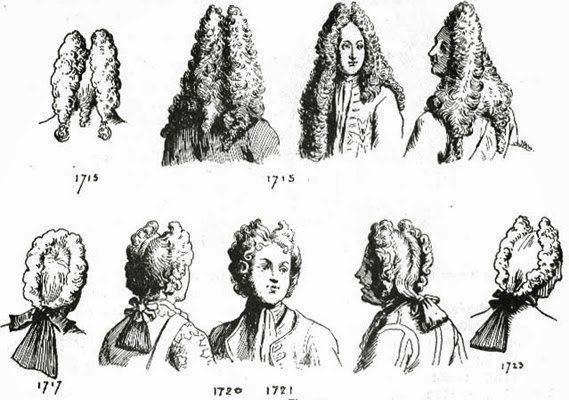
Of course, everyone in the courts wanted to emulate the Royals. Both sexes were known to wear extensions. That copycat behavior would soon trickle down to the lower classes who would find ways to follow the fad. At the end of Louis's rules, the aristocracy (for fear of their lives) stopped wearing elaborate wigs. The wigs made them stand out in the crowd. This behavior put a bit of a damper on the wig/extension market, but not for long.
The Romantic Era (1800s)
During this time we saw a great rise in faux hair. Apollo knots where super tight curls attached close to the scalp to give men a tussled look. Women loved the idea of dressing up with artistically coiffed curls.
1900s
The 1900s brought us a specialized weave called the "switch."
This hair extension was a significant breakthrough because these extensions came with a clip so they could be added or removed at the wearer's discretion. Stylists used “switch” extensions made from human hair and cost around $1.00 for a handful.
The super famous Pompadour required hair extensions and hair frames to achieve the giant frontal wave.
Other weaves made famous besides the switch were frizettes, (a loose wave) and plaits (a type of braid).
In the 1940s, long hair became all the rage, and this fueled the demand for long hair extensions.
With 1960, we see the era of big hair, like Boufondos, the French twist, Bubbles, and the ever-popular Beehive. These looks made wigs and hair extensions a popular accessory well into the 1970s. Creating a BIG head of hair required hair frames and more hair than the wearer usually had.
Women found that they could achieve a great look in half the time just by popping on a beehive wig or using a hair frame to create lift at the crown of the head.
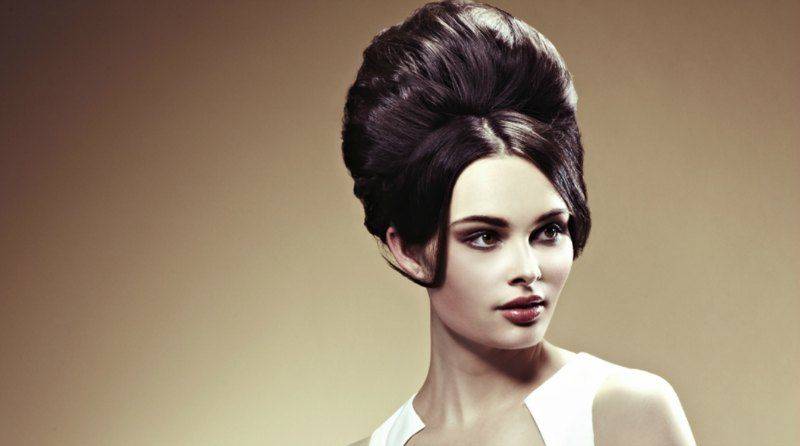
African American women made hair extensions and hair weave grow in popularity during the 80s. This popularity gave rise to more sources for weaves, hair extensions, and wigs.
By the 90s, the popularity of hair extensions caused them to become more available, less expensive, and used by women of all ages and races.
2,000s to Present
We now live in the age of hair extensions.
The choices we have are endless – Brazilian, Korean, synthetic, human, and horsehair. We can choose from every imaginable color, a wide variety of textures, and a wide array of appliance methods.
Today’s woman can thank Cleopatra for finding a way to enhance our beauty while strutting our style!
Types of Hair Extensions
Everyone has seen the beautiful results achieved through the use of hair extensions.
They can add volume to limp thinning hair, turn a chopped off bob into long locks, or give you a stylish beach wave.
There are five common methods of applying for hair extensions. Each has its own merits and subsequent drawbacks. If you are considering enhancing your appearance through the use of hair extensions, this information should be of help in making up your mind.
The five most popular types of hair extensions:
- Sew-in Extensions
- Tape-In Extensions
- Clip-in Extensions
- Micro-Links
- Hot Fusion
Sew-In Extensions
As the name suggests, stylists sew this type of weave into your hair. By weaving your natural hair tightly through a loop on the end of the extension using a unique tool. Sew-ins are ideal for all hair types.
There are many different types of sewing techniques when installing sew-in hair extensions. A full sew-in can take a few hours and there are some time-saving methods such as a quick weave in which a stylist will cut the wefts to speed up the process.
A qualified stylist should be able to complete your new ‘do in 2-4 hours, and your extensions should wear well for up to two months.
PROS
Choosing to wear a sew-in is perfect when you are transitioning between short hair and long, or if you just want to give your long hair a fuller, healthier look.
Sew-ins are versatile and come in almost any color, texture, or hair type you can imagine. This amount of selection makes your style choices endless.
This kind of variety means you have the opportunity to change your hair color, length, and style at any time without fear of damaging or over-processing your hair.
CONS
You must take great care of your natural hair while wearing sew-ins.
The added weight of the hair extensions can cause some stress on your natural hair. This adjustment is nothing a quality conditioner cannot handle!
You should also avoid unnecessary pulling or yanking on your hair. Every couple of months when you are between sew-ins, you need to let your hair “breathe” a little. This break in sew-in extensions helps your hair regain any lost moisture and allows it to regain strength.

Tape-In Extensions
Tape-in extensions are relatively new on the beauty scene.
These inch wide, hair wefts come pre-taped. Sandwiched between your pieces of hair and “taped-in.” They come in a variety of lengths, colors, and textures.
Because of the ease and affordability of tape-ins, it is currently the majority requested hair extension process in salons worldwide. These extensions have a great look, are pretty easy to maintain, and can last up to 12 weeks.
PROS
This tape-in method is one of the most affordable extension methods you will find. The application method is safer for your hair and scalp because it requires no tools, heat, or chemicals to relate.
Your tape-in application can last up to three months, AND the extensions are 100% reusable. An application session typically only takes about an hour. Because the panels of hair lay flat, these are perfect for thick or thin hair
CONS
You should not wash your hair or engage in activities that make you sweat for about 36 hours after application.
This time is needed for the bonding material to cure properly. The bonding method of curing assures that it will adhere correctly to the hair. You must avoid the use of any silicone based or oil based products. If these substances get directly on the “tape,” the hair panels could accidentally slip.
Clip-In Extensions
These are the top choice for any woman who wants a quick and easy way to transform their hair in just minutes. With these easy to use extensions, anyone can add volume, length, and wave to their hair. The extensions will last indefinitely because you can take them in and out whenever you want.
PROS
These temporary extensions are super easy to apply, and take only a few minutes to look great.
Because they attach using pressure sensitive clips instead of glue or chemicals, there is no danger of damaging to your scalp or hair. Clip-in extensions cost much less than other types, and they require no expensive, time-consuming trips to your hairdresser.
Because they just clip in, they can last much longer and need far less maintenance than other varieties of extensions.
With clip-ins, you can change your overall look at a moment's notice.
CONS
Because they are attached only by a clip, you must take care when you are brushing or pulling on your hair because you might pull it out by mistake.
If you do that, you could also pull some of your hair out with it. Care must be taken to assure the clips are placed correctly in your hair to keep them from showing.
Short hair makes it hard to hide the clips, so in very short hair your extensions could be more visible.
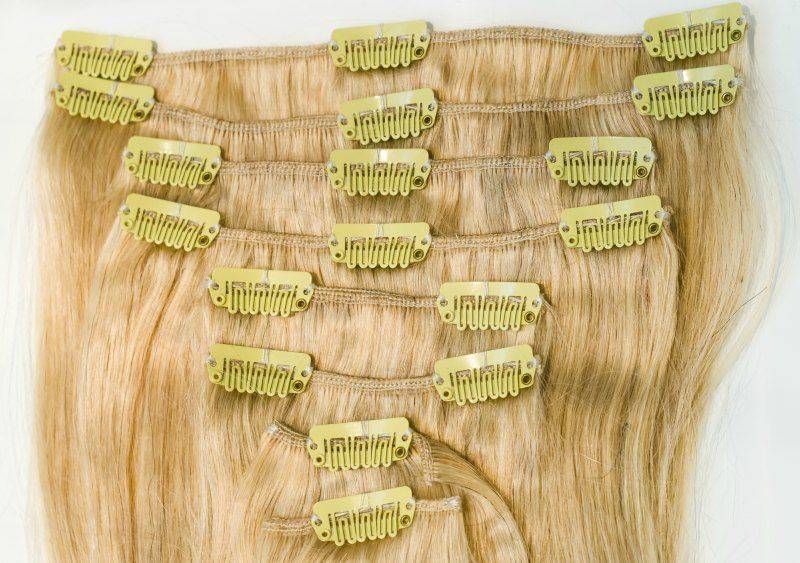
Micro-Links
Also known as, micro-beads work by attaching a weft of hair too small sections of your hair using a very tiny silicone-lined bead. After the bead is securely tightened down, it is permanently in place.
While this type of application is moderately expensive, it looks great and can last up to a full year, (it is recommended that you visit the salon every 6-8 weeks for maintenance). The longevity of the style makes the hefty price tag worth it.
PROS
No glue, chemicals, or heat is used in attaching the extensions, so, these extensions are less likely to damage your hair or scalp. While they are perfect for adding length to all hair, they are perfect for adding fullness to thinning hair.
They come in every variety of color and texture and look completely natural. They also work well for short or long hair.
CONS
In certain cases, the ‘loops’ can begin to slip down the hair’s shaft after a six weeks or so, this is why frequent salon maintenance is essential.
Over time excessive heat like that from blow dryers, curling rods, and flat irons can cause the metal micro-links to break.
A full head of micro-link extensions applied for both length and fullness can run upwards of $1,500.00 and take many hours to implement.
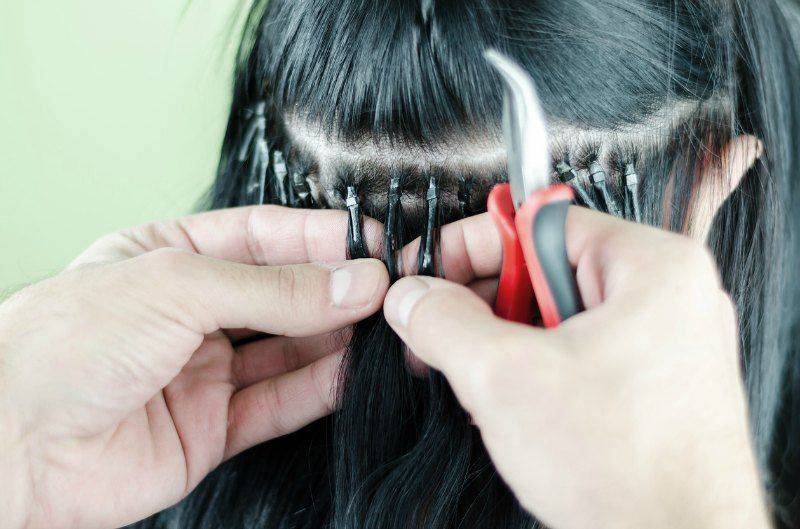
Hot Fusion
In this application, a bundle of hair attached to keratin based tips adheres to your hair shaft with a heating element. These hair extensions are also called keratin hair extensions. When properly applied they look very realistic.
PROS
This hair extension type is one of the most durable, well-wearing, and natural-looking methods of hair extensions available.
These hair extensions can be treated the same way you treat your hair. The quality of hair used in these extensions is usually superior in grade.
CONS
This procedure involves heat and glue in proximity to your scalp so that it can be excruciating.
There is a risk of damage to the hair or scalp if glue or heat is applied improperly.
This type of hair extension installation is a costly procedure that takes many hours to complete.

Various Textures of Hair Extensions
Hair extensions also come in various textures. Everything from straight to kinky, there is a texture to match your hair type.
The four main hair texture categories are straight, wavy, curly, and kinky and there are even more textures under these. Let's go into each and every texture in detail to give you a better feel and idea.
Straight
Straight hair is the classic hair extension texture. It offers a nice sleek look. With the proper tools, it can be manipulated into a variety of other textures such as wavy and curly.
Wavy (or Natural Wavy)
The wavy texture, also known as natural wavy, is like adding a slight natural wave to straight hair texture. It is the ideal wave right in between straight and curly.
Body Wave
Body wave is a loose curl that is not too straight but not too curly. The curls flow together in one piece nice and smooth.
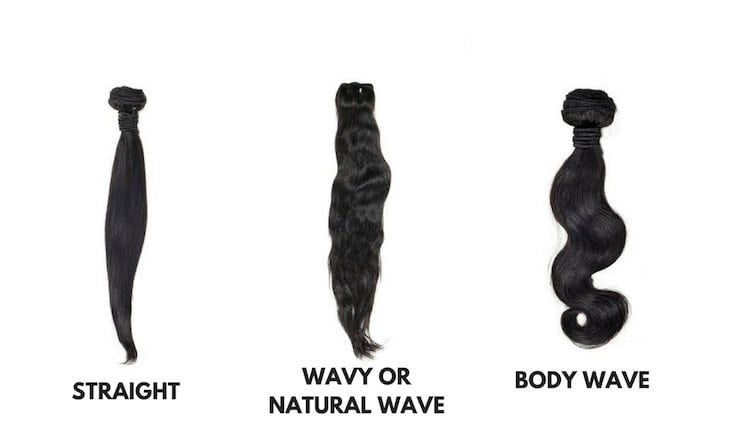
Loose Wave
Loose wave extensions are very similar to body wave except for the offer a more loose curl. Unlike body wave, loose waves don't flow in one piece.
Deep Wave
The deep wave texture offers a smooth flowing wave with a tighter curl. They are not too wavy or not too curly, they are right in between.
Spanish Wave
Spanish wave offers you the texture of hair from Latin America. A nice loose curl that looks beautiful when wet.

Curly
This is the standard curl look for virgin hair. Curly textured hair is reminiscent of the curls that you create with a curling iron.
Kinky Straight
Kinky straight offers a lightly crinkled look that looks like you braided your hair, took it out, and combed it. For those who want to go kinky but want more of a wave than a curl, this is ideal for you.
Kinky Curly
Kinky curly hair is right in between kinky straight and Afro kinky literally and look wise. It is perfect for those who want a crinkled look that is a little bit more on the curly side but not all the way.
Afro Kinky
The Afro kinky hair texture matches well with 4C hair types. It is very curly and perfect for achieving Afro hair looks especially when you comb it out.
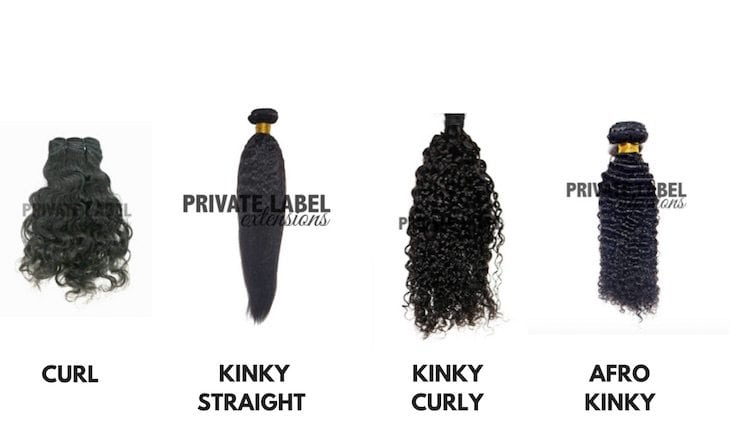
The Hair Extension Business
Did you know that almost every female celebrity you see is sporting some extensions or ‘piece?
Chances are, so are many of your friends and family. In fact, an estimated 68% of women in the U.S. today use extensions and wigs. More than 80% of those choose not to tell anyone!
That is about 58 million women nationally. African Americans comprise about 65% of that with all other ethnicities taking up the slack.
The hairpiece/ hair extensions industry is believed to currently rack up an impressive 9 billion dollars in the U.S. annually.
How did this trend become so popular and affordable? Let us look at the recent history of buying hair
The Retail Industry of Hair Extensions Before 1989
Although the human hair trade has existed for 150 years, its immense popularity with royals and aristocracy died out in the late 1700s.
Speaking in a strictly modern sense, between 1960 and 1989, the extension/wig industry was not hugely popular. Unless you were an American or European superstar, or a woman suffering from some form of hair loss, and only a handful of companies carried hair.
Supplies came primarily out of Western Europe, Eastern Europe, and (then) the Soviet Union. European Remy (high-quality virgin hair) extensions and wigs came in a multitude of styles and colors to suit the small bank of clientele.
In the early ’90s there was a drop in the availability of hair, and as the supply of humans became scarcer wigmakers and salons in Europe as well as the U.S. began looking for alternative sources.
Hair Extensions in the '80s
At the end of the 1980s, early 1990s, the sourcing for Remy hair began shifting from Europe to South Korea who had been outsourcing hair on a small scale for at least 30 years prior.
This change was the first significant shift in the extension industry. It provided an economical source of what was believed to be ‘good’ hair.
Korea became quite prominent in both the distributing and retailing sectors of the hair industry. Koreans opened a huge number of retail stores all through the U.S. This pattern soon followed suit in Western Europe, only it was the South Asian entrepreneurs entering the hair industry.
Both the SA/South Asians and the Koreans enjoyed great success in the extensions industry. Distributors, manufacturers, and retail shops appeared everywhere with Pakistanis and Indians holding ownership of 95 percent of the actual retail business, but sourcing it almost exclusively out of Korea.
Although it was about 20 years after Korea, India became a leading player in the gathering and supplying of hair around this time as well.

Hair in the 90's
India had been collecting Remy virgin hair as well recycled human hair used not for beauty, but for various industrial applications for many years.
It has some uses like most prominently the extraction of amino acids. You can find Indian Hair in different retail products. When the demand for hair for cosmetic applications became extreme, India answered the call and has now become the largest source as well as exporter of not only (Remy) virgin human hair, but recycled human hair as well.
Until the mid-90s all hair was treated the same. There was no emphasis put on the value of virgin or Remy hair. All Hair was lumped together, cleaned, processed, and dyed to be uniform in color. It was then bundled up and shipped off to for production in wigs, pieces, braids, and extensions.
Shift in the Hair Extensions Market
At the end of the 1990s, we began to see a significant shift throughout the industry with some enterprising individuals who realized the superior quality and value of Remy virgin hair. They recognized the excellent quality of the hair as well as the fact that when the cuticles are kept intact, the hair flows more naturally when installed.
They began to use this virgin hair just as it came from Indian temples.
Keeping the hair natural with the cuticle intact not only made for a more realistic head of hair, but it also keeps its good looks longer. The rebirth of hair extensions, pieces, and wigs had begun!
The retail sales profits of Remy hair extensions and wigs sold in the U.S. enjoyed explosive growth as well. This business went from around 2000 suppliers in the late 80s to around 5000 by mid-2000.
These shops were almost all Korean-owned beauty suppliers, selling Korean/American companies exclusive brands. An African-American woman is their primary customer base.
These stores featured 100% processed hair, with about 90% of that stock being human hair
The Hair Boom from 2001 to 2011
The pressure for affordable and available extensions exploded when celebrities started coming forward to tell about how much they loved theirs.
Everything from clip-ins to micro bead extensions became all the rage. Consumers became discriminating as they learned the difference in types of hair, and now virgin hair was in huge demand.
India saw a massive increase in the demand for Remy hair and adjusted the price for the supplies accordingly. At first, there was some confusion due to the lack of regulations in the “hair for sale" industry.
Because no one was assigned to regulate the quality or authentication of hair, unscrupulous dealers could sell anything packaged as Remy hair with no fear of reprisal. Certain clues would give away ‘fake’ Remy such as phrases like “good for four washes without tangling”!
REAL Remy is good for an unlimited number of washings.
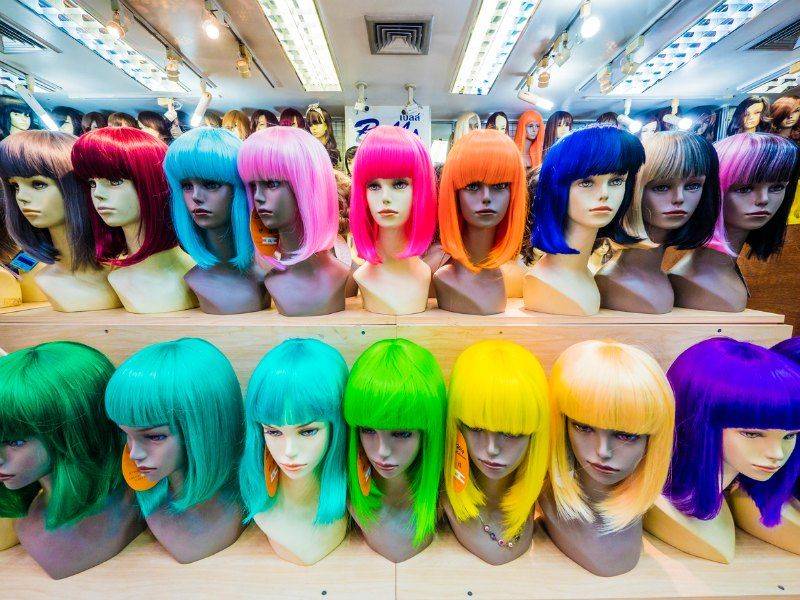
Consumers More Aware
Perceptive consumers began to understand and recognize the value of the not so subtle differences between Remy hair and processed or recycled hair.
Not until consumers realized the differences between real Remy hair and cheap imposters, they could not comprehend why the cost of so-called Remy hair extensions sold at beauty supply stores (phony processed hair). The hair extension price was noticeably lower in cost than Remy hair extensions (real virgin hair) for sale at the small number of official Remy hair suppliers in existence at the time.
Facing almost no competition no regulations and an almost perfect monopoly over the chain of supply meant big beauty supply stores could have consumers at their mercy. Many of their clientele believed their extensions to be Remy hair, but it was reprocessed hair.
Welcome E-Commerce
2005 saw a new competitor on the scene, Remy hair was now being offered through a new venue never before exploited by the wig industry – the internet. This E-commerce boom heralded a second noteworthy shift in human hair as an industry because now anyone could purchase their hair from somewhere other than a beauty supply store.
The influx of suppliers saw an industry growth of 4.9% between 2005 and 2010. In 2007, one company secured the name “virgin hair” to be the first to differentiate their Remy hair extensions from the other’s ‘Remy’ hair, a type of recycled processed hair. The best hair extension marketing techniques have been put in place by many companies to see greater success.
This bold move increased the demand in the market for authentic Remy virgin hair Sales for natural Remy extensions started to rise, and as expected, so did the supplier’s price in India.

Import / Export
Another significant development in the industry at this particular time was the evolution of a relationship between Brazil and India regarding Remy hair.
There was a sudden increase in the exporting of Indian hair to Brazil and some other South American countries. The Diaspora of Indians who decided to move Brazil in the 1970s realized there was a high demand in favor of virgin hair extensions, and it was only growing.
By the middle of the decade, Brazil was soon the major importer of Remy hair out of India. Italy and Spain were in second place. China then began to purchase 99% of all the recycled hair coming out of India.
All of the purchases were primarily for creating recycled hair extensions for sale to suppliers and beauty stores in both the States and Europe.
Because of the massive amount of imported hair, Brazil soon became recognized as a source for exceptional quality hair extensions made from real Remy. Brazilian companies took advantage of this newfound recognition and began exporting this product as “virgin Brazilian hair extensions” to the US and around the world.
This move was the inception of the second most famous hair sold today, now known to the industry today simply as “Brazilian hair extensions.”

The Hair Industry 2011 to Present
For 18 months, from January 2011 to August 2012 disaster struck the heart of the industry.
The Indian temples, a primary supplier of Remy hair for the world, suddenly decided to stop selling hair. This change was a significant happening because it forced manufacturers to discover other unique methods of selling recycled hair as real Remy hair.
Manufacturers in India perfected a method of stripping the cuticles off recycled (Remy) hair and then processing it in a silicone bath. Methods like this cleaned the impurities, dyes, and chemicals from the hair, leaving it smooth and clean, which appears to be actual Remy virgin hair.
The Process
Altered hair occurs because as soon as the hair goes through an acid bath, impurities, like dirt, bugs, oily residue, added color, or henna, are removed.
This style of manufacturing is the same process the Chinese used to produce processed recycled hair sold in the US beauty supply market.
Indian manufacturers added one significant difference to the process. Instead of coloring the acid-washed hair, manufacturers used silicone as a rinse.
This treatment helps reduce tangling, adds a luster, and makes it feel very soft. The result of this treatment is hair that has the exact look and feel of Remy virgin hair. Manufacturers in India mistakenly thought that novice and an untrained consumer would never tell the difference.
This might have been true at first, but it was soon apparent that the recycled hair was of an inherently lower quality of hair. While at first, it looked the same, it was set apart by dryness and tendency to tangling after just a few washes. The hair industry has ‘fake’ Remy hair being sold directly from the source.
Supply and Demand
Although the temples in India insisted that they are not swayed by supply and demand, when the purchases of Remy hair fell by 90% because of their price increases, they felt the crunch. Despite lower prices, exporters unintentionally bought the recycled hair believing it to be virgin Remy hair from India and Brazil. So great was the demand for this hair, the Chinese soon jumped on the ‘fake hair’ bandwagon.
They used the same techniques but mixed animal hair and synthetic fibers in to cut the cost even further. By 2016, the competition between China and India was cutthroat. They would do anything to the hair to undercut the competition and sold the inferior product under all the best names- Brazilian, Remy, Mongolian, Peruvian, etc. Cutthroat pricing and warring competition through the U.S. market wide open to a massive influx of entrepreneurs.
Now any number of startup companies could afford to purchase significant amounts of the sub-quality hair and sell it as the real thing. Promotions are prevalent in hundreds of retail outlets and even more WebPages. They truly have no idea that they are not selling real 100% Remy virgin hair. This is why in this industry is so important to use a reputable dealer that has the training and expertise to know you are getting the real thing.
Hair Entrepreneur Boom
In the last few years, typical hair salons have got in on the extension craze with almost 30% of them now offering extensions as a side service. There has also been a massive influx of Black Entrepreneurs horning in on a once prominently Korean market.
With the world’s obsession with beauty and celebrity, worship the future of hair extensions has nowhere to go but up!
Hair Extension Terms
In the world of hairpieces, wigs, and hair extensions, there are so many styles, brands, styles, and looks available it is hard to know what to ask for. Sometimes you may feel that your stylist does not know what you are talking about.
When you throw in technical terms and industry jargon, it is almost like speaking another language. If you have considered extensions, a weave, or a wig you should be informed before you go to talk to a stylist.
Here is a handy guide to commonly used terms and techniques to help you understand just what you are looking for.
Base
This one is pretty straightforward. The base of a hairpiece is the foundation upon which human hair or synthetic fiber is attached before it is applied to the wearer. The shape of the base is determined by the designer to fit the intended coverage area. In most cases, your head will be measured to assure a good fit. Hairpieces may have a solid base, they can be of complete capless construction, or they might have a hand-sewn monofilament top area. Custom hairpieces often have a lace front hairline.
Baby Hair
It is the tiny hairs added by weaving or gluing to the top front and edges along the hairline of most full lace wigs, closures, and some lace frontals. It mimics a natural hairline that gives a more natural look to the piece.
Bonds
The general term used for any of the adhesives such as keratin that are used to ‘bond’ or glue the extension piece to the hair shaft.
Bonding and Sealing Extensions Rather than weaving or sewing in extensions, this method uses a special glue that is applied directly to the extension hair weft to be attached to the wearer's hair. This process that lasts for less time than sewn in extension does. It lasts for several weeks before the glue begins to weaken.
Blended Hair
As the name suggests, this is a blending of human, animal, and synthetic types of hair. As expected, it is far cheaper than 100% human hair. This hair does have its advantages. It has an amazing ability to keep its style well for extended periods of time. It is typically soft to the touch and a far cheaper alternative to Brazilian or other types of 100% human hair.
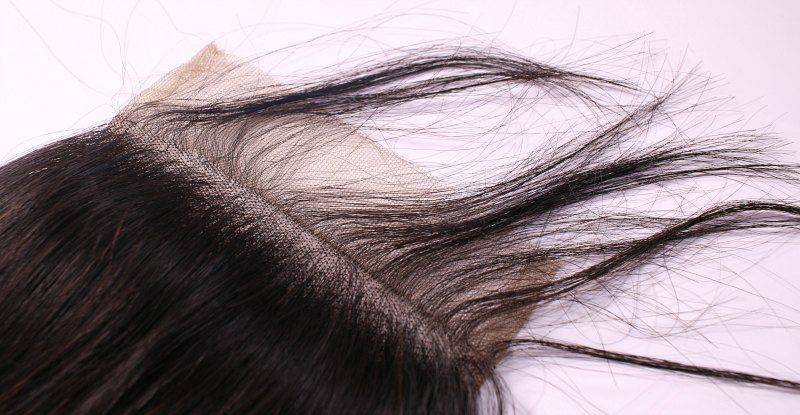
Braid Extensions
These are thin pieces of natural, animal, or synthetic hair that are braided into small braids, which are in turn braided into your natural hair to create specific hair designs or custom looks.
Brazilian Hair
This hair is a highly desired hair type because it is one of the most natural types of hair you can buy. It is also 100% human hair, easy to style, soft, luscious, and flows naturally with your head movements.
Bulk Hair
Bulk hair is a batch of unbound hair sold "packed loose." It can be synthetic or animal but is most often human. Stylists use this type of hair for a "strand by strand" application, or for making braids.
Closure
It is a small piece of thin lace covered with human hair. This closure is the piece used to mask the gap left by hair wefts, or it is used to cover the crown area of the head.
Colored Indian Remi
It is Indian Remi Virgin hair, dyed something different than its natural color (making it no longer considered virgin hair).
Cuticle Hair Extensions
The production of hair extensions by a unique method that results in a hair extension with the hair cuticles intact and running the same direction. This cuticle type hair results in a higher quality extension that will bond better and last longer.
Chemically Treated
This term refers to any process that alters or attempts to modify the condition of the hair (synthetic or natural) through the use of chemicals. This method includes coloring, perming, straightening, bleaching.

Clip in Hair Extensions
Clip-in hair extensions are temporary, hairpieces that install in a moment’s notice. Some clip-in extensions offer lesser quality human hair or synthetic hair, but still looks great.
They are an inexpensive way to play with extensions without a lot of cost and commitment. Clip-ins are typically very easy to maintain, but they should be washed and dried separately.
Clip-ins are very easy to maintain, but they should be washed and dried separately.
Please note that despite many clip-in extensions in the market are cheap and more for "fun," Private Label Extensions only carries top quality human hair clip-in extensions!
Extensions
Varying lengths of human hair, animal hair, or synthetic hair are cleaned, sorted, and sewn to heavy cords called "wefts."
These wefts are then used to attach the extension to pieces of the wearer’s hair adding a look of fullness, length, or both. Hair extensions may also be used to add highlights or low-lights to natural hair color. They can be attached to the wearer’s natural hair in many different ways.
Hair extensions may also be used to add highlights or low-lights to natural hair color. They can be attached to the wearer’s natural hair in many different ways.
Fusion
One version of the fusion method uses a particular machine slightly resembling a hot glue gun to attach the individual hair extensions to specific strands of the wearer’s hair.
Another technique involves the hair weft of the extension, which is pre-dipped in a keratin adhesive. The stylist then uses a special heat clamp to melt the adhesive, which securely attaches the extension to the wearer’s natural hair. The fusion method creates one of the most versatile, flowing, and natural-looking hairstyles available.
A Fusion weave allows frequent washing, brushing, and styling of your hair as well as the use of your usual hair products.
Hair Cuticle
The hard outer layer of the hair shaft that acts as a defensive cover for the softer center of the hair. The hair cuticle is formed from dead cells, that overlap in layers to form scales.
These scales give the hair shaft strength in addition to providing tough outer shell protection for it.

Hairpiece
This is an application most often worn at the top (crown) of your head. These hairpieces are usually worn to cover balding or thinning hair but can be used to add volume as well as length by blending in with your natural hair. Hairpieces can also be used to change your hairstyle.
Total Capless Construction
Every wig or hairpiece needs some type of base. This machine-made cap is carefully constructed and results in an entirely open weft base. Capless construction wigs are some of the best-looking, comfortable, and affordable types of wigs available today. This kind of construction also results in a cooler wig that is incredibly lightweight.
Inside Weft Hairline
This is an economical alternative to a custom hand-tied or lace front hairline. This machine-sewn fiber weft results in a very soft and well-fitting front and side hairlines of the hairpiece.
Hand-Tied Hairline
The fibers at the front and sides along the hairline of the hairpiece are painstakingly hand sewn to create a completely natural-looking appearance, great fit, and comfortable wear.
Lace Front Hairline
This custom hand-sewn monofilament front extends temple to temple across the hairpiece. The process includes separate woven strands of hair into the ventilated piece, so it more precisely imitates the real look of your hairline. It looks so good that it allows for a variety of natural, off-the-face styles and gives you the ability to part your hair in either the center or side, just like your hair.
Locking Combs
These are small combs sewn into the weft of the extension designed to help the piece stay in place and ensure comfortable wear. These combs are designed to grasp your hair without pulling, allowing you to be comfortable all day.
Monofilament
Materials include a fine-grade nylon material that is delicate as a spider web and nearly transparent. Strands of hair are attached by hand to the filament by knotting two to three strands of hair at a time. This method of individually hand tying allows the strands of hair to move freely, like your natural hair. You will find monofilament hand-tying around the top area of a hairpiece. It is specifically designed to mimic your skin tone and reproduces the look of the human scalp.
Monofilament hand-tying around the top area of a hairpiece is typical. It is specifically designed to mimic your skin tone and replicates the look of the human scalp.
Netting
Netting is a method which entails the use of a hairnet over the top of the wearer's hair. After their hair is tightly braided in rows, the extensions are then sewed on to the braids and netting. This method provides a smooth surface for applying the extensions to and the ability to sew the extensions across the entire net not just to each braid. With netting, you also have the option of bonding the wefts to the net, or sewing in the braids.
This method is more efficient and takes less time than other techniques, but still, creates a great look.
Remy Hair
A premium grade of 100% human hair that undergoes a particular type of processing. This procedure helps to minimize the removal of the hair’s natural cuticle. Having the cuticle on the hair shaft allowing for a more expected look when the extension is applied.
By maximizing the number of hair cuticles running in the same direction—the way hair naturally grows.
More on Remy Hair.
Stretch Ribbon Lace
Stretch ribbon is used to create a foundation frame for the base of a hairpiece. This helps to add stretch and security to any hairpiece.
Tracking
Tracking is one of the most widely used techniques for applying for hair extensions because it is fast and lasts a good long time.
NOTE this method does not use the wearer’s natural hair as part of the style. Instead, a person's natural hair is braided (cornrows) across the head, and the extensions are sewn parallel to the head in a crossways pattern. Moving from side to side, starting on the bottom row, hair weft extensions stylists sewn to the actual braids.
The number of tracks involved depends on the desired look. It can be from a few lines to create length to a full head.

Velvet Comfort Band
A soft velvet-like fabric between 1-2 inches wide that is used to sew in the inside front portion of a hairpiece. This strip is designed to increase comfort and keep the hairpiece from slipping.
Velvet-lined Front
This is a more cost-efficient version of the Velvet Comfort Band. The velvet-lined front is only ¼" to ½" wide, and the velvet-like fabric is hand sewn to the front underside of the hairpiece. Like the comfort band, it helps to prevent the piece from slipping.
Weft
A weft is a process of stitched strands of synthetic or real hair as a means of preparing it to be attached to your head. Strands of hair prepped in this way is used when doing hair sewing/weaving, keratin technique, or used with clips. Best results are from double stitch wefts that reduce the chance of hair shedding.
Yaki Hair
Yaki hair refers to a particular type of hair used in extensions, weaves, closures, wigs, and hairpieces. Unlike Remi hair, which refers to hair that goes through a specific type of harvesting process, Yaki hair refers specifically to a hair texture that resembles the relaxed.
Afro-Caribbean Hair
Another difference is that Remi hair is most often harvested from a single source allowing the cuticles to be kept intact, Yaki hair, can, in fact, be Remi, other human hair, or synthetic.
Silky Yaki
This hair type is Yaki’s answer to Silky Straight, the same great look with a little more texture.
Popular Hair Extensions Styles
Every year there appears to be a new hot "style" of hair extensions.
The long and lustrous "straight" hair is too bland for many. Similar styles have names created more for marketing purposes than an actual new look.
Let's take a look at the most popular hair extension styles currently available.
Body Wave
This s-pattern hair extension style is a classic!
The body wave style is our #1 selling hair extension curl pattern.
Straight
Straight is always in style!
The shorter lengths make for a great Bob, and the longer luxurious lengths can flow down a woman's back.
Loose Wave
Think "Body Wave" with a twist!
This popular hair extension has a beautiful spiral curl that will flow down your shoulders. Easily style this with anticipation of big curls!
Deep Wave
Oh so popular and sexy!
The curls are getting a little tighter. Think about it as more of beautiful waves of hair. A woman will generally add an extra deep wave bundle to their sew-in for a really full look. It's just the style!
Kinky Curly
We are starting to break into the "Natural Look" styles here.
Kinky Curly has a tighter curl pattern. This hair extension is the most popular of the tighter coil hair extensions. Once the kinky curly bundles are installed and brush the hair out you will see a full and natural hairstyle.
Afro Kinky
Now we are talking about "Natural Style" hair!
The Afro Kinky hair extensions have an even tighter coil than the Kinky Curly. As a matter of fact, it is half the coil size.
Kinky Straight
What a fun style!
The hair is worn long and has a slightly "crimped" style that kind of reminds me of the '80s. Kinky Straight is great when worn as a ponytail or a fun night out!
Natural Wave (Non-Uniformed Pattern)
Not all hair is created equal.
Most hair extensions sold in the USA have curl patterns created with steam. Nothing wrong with this process as it has helped transform naturally straight hair into the great styles we have today.
The naturally Wavy Indian Hair is one type of hair extensions that is in its natural state. The waves are just part of the hair's DNA and make for a great look.
Loose Deep Wave
This hair extension is a new style that has recently hit the market and is growing in popularity.
The Loose Deep Wave is a combination between the Loose Wave Hair and Deep Wave Hair. We love the unique look and additional styling options it offers a woman.
Tight Coil (Jerry Curl)
The style is just as you can imagine.
This hair extension has a tight coil but a more uniformed look than say an Afro Kinky Extension that has a more natural flow of hair.
Water Wave
This sexy hair extension style is a new style to the market that has a fun, natural look.
It has a messy Body Wave style that looks fantastic when sewn in.
Spanish Wave
Also known as a "Beach Wave", this hair extension style has quickly grown in popularity.
Perfect style for the beach with a Latin flare!
Conclusion
Hair Extensions are a booming business that has been around longer than most people think.
The popularity has only grown over the years.
Competition is fierce in the industry but as it continues to grow there is more room for successful entrepreneurs looking to get into the hair game.
I find that woman is so passionate about hair that it makes a great business for them. The key to success is to stay consistent with your marketing & sales efforts.
The momentum of the hair industry is solid as beauty has become a larger part of everyday life. Social networks like Facebook, Instagram, and Pinterest are adding fuel to the fire as everyone wants to look good for likes.
Hair extensions make a woman feel great and allow them to transform their look to how they feel quickly.
The team at Private Label Extensions is passionate about the hair industry, and if you read this entire article we are sure you are too!

